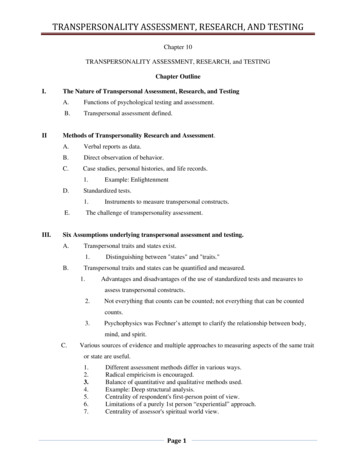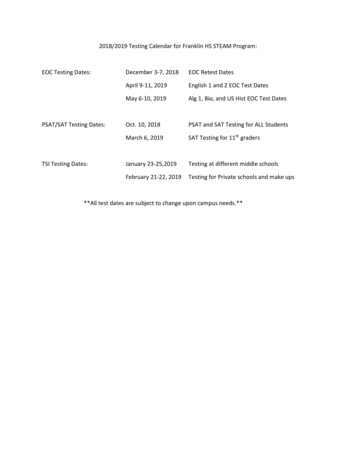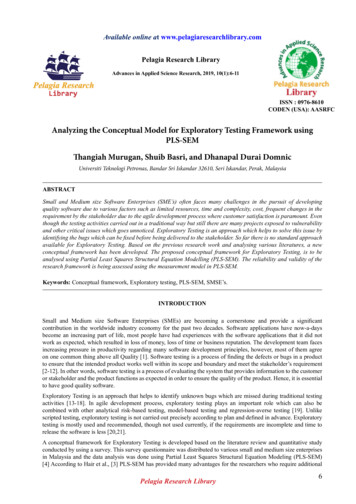
Transcription
TRANSPERSONALITY ASSESSMENT, RESEARCH, AND TESTINGChapter 10TRANSPERSONALITY ASSESSMENT, RESEARCH, and TESTINGChapter OutlineI.IIThe Nature of Transpersonal Assessment, Research, and TestingA.Functions of psychological testing and assessment.B.Transpersonal assessment defined.Methods of Transpersonality Research and Assessment.A.Verbal reports as data.B.Direct observation of behavior.C.Case studies, personal histories, and life records.1.D.Standardized tests.1.E.III.Example: EnlightenmentInstruments to measure transpersonal constructs.The challenge of transpersonality assessment.Six Assumptions underlying transpersonal assessment and testing.A.Transpersonal traits and states exist.1.B.Distinguishing between "states" and "traits."Transpersonal traits and states can be quantified and measured.1.Advantages and disadvantages of the use of standardized tests and measures toassess transpersonal constructs.2.Not everything that counts can be counted; not everything that can be countedcounts.3.Psychophysics was Fechner’s attempt to clarify the relationship between body,mind, and spirit.C.Various sources of evidence and multiple approaches to measuring aspects of the same traitor state are useful.1.2.3.4.5.6.7.Different assessment methods differ in various ways.Radical empiricism is encouraged.Balance of quantitative and qualitative methods used.Example: Deep structural analysis.Centrality of respondent's first-person point of view.Limitations of a purely 1st person “experiential” approach.Centrality of assessor's spiritual world view.Page 1
TRANSPERSONALITY ASSESSMENT, RESEARCH, AND TESTINGD.All assessment methods have strengths and weaknesses and various sources of error.1.Artificiality of psychometric measurements and laboratory experiments may beinappropriate to the phenomenon under study.2.Conceptual and methodological difficulties in defining and quantifyingtranspersonal traits and states.E.Assessment can help point the direction to transpersonal phenomena that require furtherstudy.F.IV.1.“Separateness science” and “wholeness science” compared.2.The need for new epistemological nets.Transpersonal assessment can provide valuable answers to important questions.ConclusionPage 2
TRANSPERSONALITY ASSESSMENT, RESEARCH, AND TESTINGChapter 10TRANSPERSONALITY ASSESSMENT, RESEARCH, and TESTINGLearning Objectives1. Describe the purpose and functions of psychological testing and assessment in conventional andtranspersonal psychology.2. Identify the main points of difference between conventional and transpersonal approaches toassessment.3. Define the transpersonal orientation in psychology.4. Define transpersonal assessment.5. List the different research and assessment approaches that may be employed in clinical practiceand the research setting to gather information about human personality and its transpersonalaspects.6. Discuss the value of verbal reports as data in psychology.7. Identify the variables that affect the completeness and accuracy of verbal reports.8. Explain why verbal reports may be difficult to interpret and discuss their limitations.9. Discuss the main points of difference between naturalistic observation and laboratorydemonstration for assessing the nature, limits and reality of transpersonal aspects of humanpersonality functioning.10. Discuss the advantages and disadvantages of case studies, personal histories, and life records as asource of information about the transpersonal dimensions of human personality action.11. Describe how the case study method has been applied to the study of the transpersonal experiencecalled "enlightenment."12. Identify the various psychometric issues that the assessment of transpersonalconstructs/phenomenon must address.13. Discuss the three psychometric issues that McDonald et al. (1995) identified as particularlyimportant to transpersonal assessment.14. Identify seven self-report standardized questionnaires and inventories that can potentially guidefurther assessment and research into the transpersonal dimensions of human personality.15. Discuss the challenge of transpersonality assessment to construct, design, and develop tests thatare a meaningful, reliable, and valid as the behavior that they are intended to assess. Provide oneexample.16. Identify and discuss the six assumptions that underlie the assessment of transpersonal constructsof human personality.17. Distinguish between "states" and "traits."18. Explain how the attribution of a trait or state to an individual or its presumed strength ormagnitude is always a "relative" phenomenon.19. Identify the main obstacle to the study of spiritual or transpersonal experiences, according totranspersonal psychiatrist Stanislav Grof.20. Discuss the value of standardized, paper-and-pencil assessment instruments in transpersonallyoriented research and assessment.21. Explain the meaning of the phrase, "Not everything that counts can be counted; not everythingthat can be counted counts," and give one example.22. Describe Fechner’s attempt to clarify the relationship between body, mind, and spirit and theactions that eventually lead to his creation of the field of psychophysics23. Explain why the assessment of transpersonality action is not something to be confined to thelaboratory or to the use of psychological tests alone.24. Describe how transpersonal researchers take a multi-layered, pluralistic approach to the study oftranspersonal aspects of human personality.Page 3
TRANSPERSONALITY ASSESSMENT, RESEARCH, AND 9.Describe the different dimensions on which various assessment methods differ from one another.Explain why more than one data source is used in transpersonal assessment.Describe difference between conventional and transpersonal research methods.Distinguish between quantitative and qualitative methods of research, and discuss the advantagesand disadvantages of each.Describe the transpersonal assessment method called “deep structural analysis.”Explain why obtaining the respondent's first-person point of view of a phenomenon is crucial tounderstanding the nature of transpersonal experience.Describe the limitations of a purely 1st person “experiential” approach to transpersonalexperience.Explain why the assessor's spiritual world view is central in the assessment of transpersonalexperience and behavior.Define measurement error.Explain how the artificiality of psychometric measurements and laboratory experiments may beinappropriate for the study of certain transpersonal phenomena.Identify and discuss the main conceptual and methodological difficulties in defining andquantifying transpersonal traits and states.Identify and discuss the main differences between a conventional and transpersonal approach topsychological research and personality assessment.Compare separateness science and wholeness science, as defined by Braud & Anderson (1998).Explain why modern psychological science assessment as it stands today requires "a newmetaphysical net" if it is to catch the meaning, function, and reality of the transpersonaldimension of human personality action.Explain how transpersonal assessment can help answer questions about the field's ethical andsocial accountability clients and regulating agencies as well as scientific validity and treatmentefficacy.Page 4
TRANSPERSONALITY ASSESSMENT, RESEARCH, AND TESTINGChapter SummaryThis chapter examines the nature of transpersonal psychological assessment, the methods of transpersonalresearch and testing, and the assumptions that underlie the assessment and evaluation of transpersonalexperiences and behavior. First, the functions of transpersonal testing and assessment are identified andtranspersonal assessment is defined. Second, the various methods and psychometric approaches used intranspersonality research and assessment are examined, including the use of verbal reports as data, directobservation of behavior, case studies, personal histories, life records, and standardized tests. The exampleof how to assessment and evaluate the experience of "enlightenment" is presented to illustrate howresearch in this area has been conducted. A list of over 30 standardized instruments used to measuretranspersonal constructed is provided and the challenges that face any researcher who seeks to define,quantify, and measure constructs such as "transcendence" or "spirituality" are discussed. Six assumptionsunderlying transpersonal assessment and testing are also identified and discussed: (a) transpersonal traitsand states exist, (b) transpersonal states and traits can be quantified and measured, (c) various sources ofevidence and multiple approaches to measuring aspects of the same trait or state are useful, (d) allassessment methods have strengths and weaknesses and various sources of error, (e) assessment can pointthe direction to transpersonal phenomena that require further study, and (f) transpersonal assessment canprovide valuable answers to important questions. The chapter distinguishes between "states" and "traits."The advantages and disadvantages of the use of standardized tests and measures to assess transpersonalconstructs are discussed. The notion that transpersonal traits and states can be quantified and measured isexamined in light of Gustav Fechner's attempt to clarify the relationship between body, mind, and spirit inhis formulation of the experimental science of psychophysics. The recognition that different assessmentmethods differ in various ways brings to light the need to use multiple assessment methods wheneverinvestigating a particular transpersonal experience or behavior. The balanced use of both quantitativeand qualitative methods is described. An example of the use of a combination of qualitative andquantitative methods is presented in the work of Wilber's "deep structural analysis." Both the importanceand limitations of taking a first-person point of view toward transpersonal experiences are examined. Theassessor's spiritual world view is presented as also important in transpersonal assessment. The artificialityof psychometric measurements and laboratory experiments as being inappropriate to the investigation ofsome transpersonal phenomena is highlighted. The conceptual and methodological difficulties in definingand quantifying transpersonal traits and states are also presented. The differences between traditionalpsychological assessment and transpersonal approaches are discussed and the need for an expansion ofassessment methods and theoretical frameworks better suited to the creativity of the phenomena understudy (e.g., spirituality, peak experiences, self transcendence, and so forth) is examined.Page 5
TRANSPERSONALITY ASSESSMENT, RESEARCH, AND TESTINGChapter 10TRANSPERSONALITY ASSESSMENT, RESEARCH, and TESTINGThe Nature of Transpersonal AssessmentFunctions of psychological testing and assessment. Psychological testing and assessment is a commonlyaccepted professional clinical practice that plays an important role in mainstream psychology by helpingtherapists understand and describe a client's current level of psychological functioning (i.e., diagnosis),select appropriate therapeutic treatments (i.e., prognosis), and demonstrate the effectiveness of particulartreatments (i.e., efficacy studies). Testing and assessment performs all these functions in transpersonalpsychology as well, in addition to helping to provide scientific verification of the validity of transpersonaltheories and constructs of the human personality. What transpersonal assessment does do that ordinary,conventional approaches to psychological assessment does not is incorporate notions of spirituality and atranspersonal orientation into one's understanding of human personality function.A spiritual or transpersonal orientation can be understood generally, without allegiance to anyspecific theory, as involving the perception that non-ordinary states of consciousness, especiallythose which take the individual beyond her/himself (i.e., transpersonal experiences) are valid,available to everyone, and have potential for creating levels of health and adjustment whichinclude but also extend beyond traditional views of health. Examples of these types of nonordinary states are experiences which have been labeled peak, mystical, spiritual, [trance], andreligious. Furthermore, the adherence to theories (e.g., Wilber, Grof, Washburn) whichincorporate these experiences into the explanation of human functioning and their application toenhance the growth and development of self-awareness and increased health of both practitionerand client constitutes a transpersonal orientation. (Friedman & MacDonald, 1997, p.110)What transpersonal assessment contributes to assessment in mainstream psychology is the systematicapplication and integration into traditional assessment practices "a model of the human psyche thatrecognizes the importance of the spiritual or cosmic dimensions and the potential for consciousnessevolution" (Grof, 1985, p. 197).Transpersonal assessment defined. In line with convention use of the term, assessment can be defined as"the gathering and integration of psychology-related data for the purposes of making a psychologicalevaluation, accomplished through the use of tools such as tests, interviews, case studies, behavioralobservation, and specially designed apparatuses and measurement procedures" (Cohen, Swerdlik, &Phillips, 1996, p. 6). Personality research can be defined as research that involves "asking and answeringquestions about why people act, feel, and think as they do" (Liebert & Liebert, 1998, p. 26).Transpersonal assessment and personality research would include these conventional approaches toassessment and research while also including transpersonal theory into its practice for purposes of notonly "expanding our ability to understand and provide interventions to clients [but also] as a means toverify empirically the validity and effectiveness of transpersonal practices" (Friedman & MacDonald,1997, p. 113).Transpersonal assessment may be defined as an activity requiring professional judgment wherebythe practitioner and client work collaboratively at arriving at an expanded conception of theclient, including viewing non-ordinary states and both their antecedents and consequences aspotentially, but not necessarily, beneficial, for the purpose of enhancing the client's growth anddevelopment of self-awareness and health. In the process of developing such an understanding ofthe client, the practitioner relies upon transpersonal theory in a systematic way (i.e., through theuse of standardized measures of transpersonal constructs) and examines his/her potential biases asPage 6
TRANSPERSONALITY ASSESSMENT, RESEARCH, AND TESTINGan essential aspect of the assessment process. . . . Thus, the main points of difference betweenconventional and transpersonal approaches to assessment are that the latter utilizes transpersonaltheory and methodologies to understand a client, requires that the assessor and client activelycollaborate, and emphasizes the explicit role of clinician awareness of potential biases inprofessional judgment used in the transpersonal arena. (Friedman & MacDonald, 1997, p. 112)This definition of transpersonal assessment incorporates transpersonal theory into its description ofassessment, does not exclude conventional approaches and uses of assessment data (e.g., diagnosis,treatment recommendation, prognosis, treatment evaluation), re-focuses the goals of assessment onpsychological growth and development beyond that of the conventional reductionistic, problem-oriented,medical model of disease and dysfunction, and allows for the inclusion of alternative assessment andtreatment methodologies that have evidence supporting their validity and clinical usefulness (Braud &Anderson, 1998; Hart, Nelson, & Puhakka, 2000; Krippner & Welch, 1992; Palmer, 1998).Methods of Transpersonality Research and AssessmentMany different research and assessment approaches may be employed in clinical practice and the researchsetting to gather information about human personality and its transpersonal aspects. Interviews,questionnaires, standardized testing, behavioral observation, Physiological measurements, case studies ofpersonal histories and life records are just a few of the many sources of information that transpersonalpersonality psychologists use to draw inferences about transpersonal aspects of human personality.Verbal Reports As DataAmong the most common sources of information about transpersonal dimensions of human personalitycome from self-report methods such as face-to-face interviews that provide quick and easy access to aperson's subjective internal experiences. Verbal reports, being a primary medium of interpersonalcommunication, have traditionally been a valuable source of useful data for psychologists (Boring, 1953)They aid in the prediction of behavior, correlate with physiological measurements, provide informationrelevant to the diagnosis and treatment of disorders, provide complementary information to behavioralobservations, and suggest hypotheses for the research scientist to test and evaluate (Ericsson & Simon,1984). Verbal reports contain enough information about the structure of thought to be translated intocomputer simulations of cognitive processes involved in problem-solving, for instance, and are used incourts of law as evidence under certain circumstances. Variables that affect the completeness andaccuracy of verbal reports include: time of report, the kinds of information requested, failure to attend toexperience, censoring or evaluative processes, task requirements, availability of automatized practicedresponses, availability of verbal concepts, lying and willful deception by the subject, wording of theinterview or questionnaire item, correspondence in verbal meanings of assessor and the respondent,familiarity with the interview and questionnaire format, and attitude and set of the respondent (Ericsson &Simon (1984).Verbal reports are also difficult to interpret and are limited by an individual's verbal skills and capacity tointrospect and remember (Nisbett & Wilson, 1977), especially when they are in an alternate state ofconsciousness (Cunningham, 1986). Both perception and memory of a transpersonal experience and itsconcurrent or retrospective self-report will be influenced by the physical and mental condition of theindividual (e.g., medication, level of arousal, fatigue and other motivational variables). Moreover, selfreport measures do not provide direct assessment of experiences such as "spiritual enlightenment" or anyother transpersonal construct but only indirect assessments of the correlates, consequences, and verbalexpressions of such experiences (i.e., the phenomenology of the experience or "what it was like"). Manytranspersonal experiences (e.g., mystical states of consciousness) are often reported as being ineffable or"beyond words." Self-reports are particularly limited in describing inner psychological states by whatPage 7
TRANSPERSONALITY ASSESSMENT, RESEARCH, AND TESTINGWilliam James (1890/1950) called "the vocabulary of outward thing" (p. 194). There will always be agap between thoughts and feelings and the words used to convey them. Indirect assessment techniquesthat are "disguised" (e.g., projective tests) may be used to bypass response bias that may distort selfreports, but responses still need to be interpreted. In this way, the clinician's or test developer's values,beliefs and attitudes comes into play to influence the interpretation of assessment results. Becausetranspersonal psychologists may disagree on how to interpret what a person reports, and because of theimportant role that the clinical judgment of the therapist plays in diagnosing and treating personalitydisorders, it becomes "particularly crucial for transpersonal assessors to actively examine their biasesduring assessment" (Friedman & MacDonald, 1997, p. 111).Direct Observation of BehaviorA second way to learn about why people act, feel, and think as they do during exceptional transpersonalexperiences and performance of transformative behaviors is to observe them directly in particular settingsor situations. The situations may be contrived laboratory settings or natural field setting. Naturalisticobservation may have more credibility as a source of evidence for a particular transpersonal phenomenonthan observations in contrived laboratory settings because of its greater external validity, althoughlaboratory experiments may have stronger internal validity because of it permits the researcher tomanipulate, control, and measure variables of interest (Cook & Campbell, 1979). Many transpersonalexperiences occur most naturally and typically in response to human needs, which is why William James’(1902/1936) Varieties of Religious Experiences is such a rich source of insight and understanding intodramatic forms of religious behavior and attitudes. Transpersonal philosopher Stephen Braude (1997)cogently argues that naturalistic observation is an extremely valuable source of information concerningthe nature and limits and even the reality of transpersonal aspect of human personality functioning. Alaboratory experiment or standardized test would not allow us to infer the nature, limits, or even existenceof most ordinary human abilities if they did not manifest themselves first in the non-laboratory setting ofeveryday life. There are many provocative demonstrations of personality action studied by psychologiststhat cannot be easily removed from their naturally-occurring context (e.g., trance channeling, luciddreaming, psi functioning, near-death experience, out-of-body experience, mystical experience). Suchevidence is at least as valuable and reliable as the evidence gathered from contrived laboratoryexperiments or formal psychometric testing, and probably more so, because of its external validity.Case Studies, Personal Histories, and Life RecordsA third source of information about the transpersonal dimensions of human personality action can befound by studying an individual's life history and biographical record. Case studies examine the life andactions of a single individual in great detail. Like naturalistic observations, they can reveal the richnessand complexity of the transpersonal aspects of human personality in a way that few other methods can.Because case study observations are not made under controlled conditions, are not directly repeatable,often come from retrospective reports with associated memory distortions, and do not allow for simple,direct comparisons across groups of people, they may not always serve as credible scientific evidence forsubstantiating the validity of transpersonal constructs or the effectiveness of transpersonally-orientedpsychotherapies.Most investigations [of transpersonal psychotherapy] involve case studies which are useful indemonstrating the principles and potential utility of transpersonally oriented psychotherapy asthey unfold in the context of clinical work (e.g., Miller, 1993) but, at best, provide only anecdotalevidence to support the general validity and effectiveness of such interventions. (Friedman &MacDonald, 1997, p. 106)Page 8
TRANSPERSONALITY ASSESSMENT, RESEARCH, AND TESTINGNevertheless, case study material can serve as a rich source of hypotheses about transpersonal experienceand behavior that can be subsequently tested with more controlled and rigorous methods such ascorrelational studies and experiments.Example: Enlightenment. Consider, for example, how the case study method has been applied to thestudy of the transpersonal experience called "enlightenment." The experience of “enlightenment” inhuman personality has been characterized in the mystical traditions of the East as involving a form ofheightened awareness during both waking and sleeping states of consciousness. Through advancedmeditation practice, human personality can allegedly access so-called “pure consciousness” bydeveloping a “witness” – a silently observing portion of the self that witnesses all other states ofconsciousness (waking, dreaming, and dreamless sleep) without trying to change them (see, for example,Deikman, 1982). Maharishi Mahesh Yogi, the founder of Transcendental Meditation (or TM) defined“cosmic consciousness” operationally as the ability to maintain pure consciousness throughout a 24-hourperiod of waking, dreaming, and deep sleep (Roth, 1987). Is such a state of consciousness in humanpersonality functioning fact or fiction? An advanced practitioner of Transcendental Meditiation demonstrated enhanced awareness of dreams (called “lucid dreaming”) and the ability to maintainedheightened awareness in unbroken continuity throughout a twenty-four-hour cycle of waking, dreaming,and deep sleep (as operationalized by increasing EEG coherence across left and right hemispheres of thebrain during both waking and dreaming states (Gackenbach, Moorecroft, Alexander, & LaBerge, 1987).Apparently,Meditation serves to stabilize the experience of consciousness in sleep . Meditation doescontribute to the continuity of consciousness in sleep and helps to stabilize it Once an individualhas reached this level, he or she may often or continually be an observer of him- or herself in thewaking state. (Gackenbach & Bosveld, 1989, pp. 150-151)This state of consciousness is also called “the Great Realization.” The lucidity that this individual humanpersonality brings into sleep causing her to “awaken” to the fact that she is dreaming is also brought intothe waking state to cause her to “awaken” to the fact that her everyday waking experience is actually adream (LaBerge, 1993).Standardized TestsA fourth source of information about the transpersonal aspects of an individual's personality is apsychometric test or self-report personality inventory. MacDonald, Leclair, Holland, Alter, & Friedman(1995) state that "transpersonal psychology involves not only the direct study of transpersonalexperiences but also the study of the expressions and [behavioral, physiological, cognitive/emotional,sociological] correlates of this experience, a task for which psychometric tests can prove valuable. . . .Standardized measures of transpersonal constructs can be utilized effectively to support transpersonaltheory" (pp. 172-173). Self-report personality inventories are essentially specialized questionnaires thatrequires individuals to respond to a series of items in a variety of possible formats (e.g., indicating thedegree to which they agree or disagree with the statement, the item is true or false for them, the frequencywith which they engage in the describe behavior, and so forth), scored on a number of dimensions orscales to reveal the "personality pattern" of a particular individual. As with all psychometricmeasurements in psychology, the assessment of transpersonal constructs/phenomenon must address theissues of reliability (test-retest, internal consistency),content validity (adequately operationalizing the construct in terms of the behaviors andverbalizations that truly reflect the phenomenon/ construct),Page 9
TRANSPERSONALITY ASSESSMENT, RESEARCH, AND TESTING concurrent validity (degree to which the test score is related to some standard or criterion measureobtained at the same time),predictive validity (degree to which the test score predicts some other criterion measure),construct validity (adequately distinguishing between those who are known to have theexperience and those who have not), andresponse bias (i.e., adequately distinguishing between those who have had the experience andthose who have not but who say they have).McDonald et al. (1995) identify three of the above issues as particularly important to transpersonalassessment: (a) content validity (i.e., the lack of agreement among transpersonal psychologists regardingthe operationalization of any given construct beyond its phenomenological dimensions because of thelack of knowledge about transpersonal states of consciousness and to their inherent "ineffability"), (b)construct validity (i.e., how can testers empirically demonstrate that their assessment is assessing whatthey claim it is assessing), and (c) response bias (i.e., can the test distinguish reliably between those whoactually have a transpersonal experience and those who don't but claim that they do?). Nelson (1989) alsopoints out another key issue relevant to the proper selection of psychometric instruments used to assesstranspersonal constructs: "Many of the older instruments of personality assessment [e.g., MMPI] weredeveloped from psychological models based on psychopathology. . . , and there was a tendency toimplicitly connect transpersonal experiences to regressive and psychotic states" (p. 195). Instruments tomeasure transpersonal constructs need to be used and developed that are not based upon psychologicalmodels that assume transpersonal experiences are some type of personality disorder.Instruments to measure transpersonal constructs. McDonald et al., (1995), MacDonald, Friedman, &Kuentzel (1999), MacDonald, Kuentzel, and Friedman (1999), and Ak yalcin, Greenway, & Milne (2008)together provide a substantial survey of more than 30 self-report personality inventories designed tomeasure transpersonal constructs that "can potentially be used advantageously in an applied professionalcontext as part of a transpersonal clinical assessment" and as a means of facilitating the growth oftranspersonal psychology as an empirical science by their continued use in transpersonally orientedresearch into human personality (Friedman & MacDonald, 1997, p. 114). Rather can generate newpsychometric instruments for each of the various transpersonal constructs currently in place in a host oftranspersonal theories, the use of current transpersonal instruments commonly employed in researchactivities -- especially those whose psychometric pr
10. Discuss the advantages and disadvantages of case studies, personal histories, and life records as a source of information about the transpersonal dimensions of human personality action. 11. Describe how the case study method has been applied to the study of the transpersonal experience called "enlightenment." 12.










